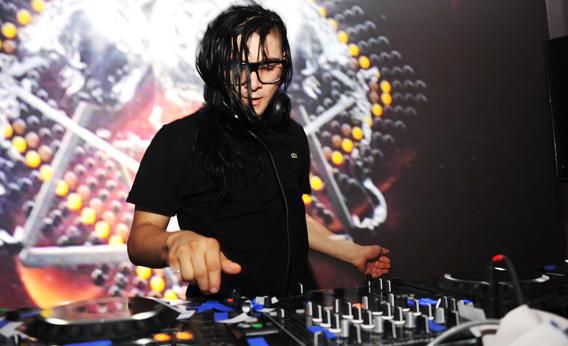Hi Ann, Jody, Lindsay, Will:
Allow me to crib a song title from the 1980s synth-pop group Re-Flex and ask: Can we talk more about the politics of dancing? Lindsay, your phrase “the Skrillex-ification of pop radio” is totally on point; and Ann, I want to riff on your celebration of the centrality of dancing in pop. Nothing in music news devastated me more this year than the passing of Donna Summer (not even the unexpected death of Whitney Houston). To mourn, I created a comprehensive Donna Summer iTunes playlist and put it on constant repeat. I’m more convinced than ever that her early Giorgio Moroder-produced tracks (which helped create the sonic template for today’s EDM, not to mention the template for cyborgian femme pop acts like Ellie Goulding), still sound more thrillingly erotic and marvelously sinister than almost anything else today on the, er, radio.
Sometime around 2007, EDM began to displace Dirty South Hip Hop as the creative engine of Top 40 pop. That displacement has had its uses, especially given the way EDM pop has served as a musical analogue to LGBTQ self-determination. But five years later, aural rigor mortis has begun to set in. As I see it, the central problem facing mainstream pop right now is its marginalization of deep groove: You know, the kind that makes you want to immediately stand up wherever you are and shake your ass because your mind has been forever blown.
There’s no shortage of vintage, analog-era grooves to go around this year. I happen to love retro-maniac acts like Allen Stone (he’s got to work on his lyrics though), and I dig that Bruno Mars can deliver a substantial mid-’80s synth groove like “Treasure” on Unorthodox Jukebox. We can also point to buzzing “underground” dance scenes like Afrobeats, queer house, witch house, and what have you: None of this music has yet infiltrated the mainstream in a significant way. R&B is more “B” than “R” these days, though Miguel’s slow burn “Adorn” excavates a classic Marvin groove, and Frank Ocean’s “Pyramids” has a brief sojourn into ’80s synth bass heaven. But those grooves are of the sleepy Quiet Storm variety, in contrast with the whimsical and innovative digifunk grooves crafted by superproducers like The Neptunes and Timbaland in the 1990s and 2000s, “urban” grooves that forever radicalized white pop.
Ann, I’d venture that just because audiences are buying and listening to dance music in droves doesn’t mean they’re necessarily dancing to dance music—especially given the increasing privatization of listening in the era of the iPod and Beats headphones. And just because people are increasingly aggregating in a club or at a festival doesn’t necessarily mean that they’re actually doing any meaningful dancing in those settings or having the kind of rich interpersonal physical exchanges we associate with classic dance rituals of, say, the disco or the jukejoint of yesteryear. Jumping up and down to a loud bombastic four on the floor beat does not automatically equate to transcendent dancing.

Photo by Theo Wargo/Getty Images for Samsung.
In some of the ultra-chic clubs playing pop and “main room” house that I visited this year in Dubai, I witnessed very little actual dancing. Instead, I mostly saw upwardly mobile denizens buying drinks at the bar, lightly bobbing their heads or tapping their feet, or waiting on bottle service to visit their table. In 2012, I purchased or listened to a lot of music that could be described as energetic or high-energy dance pop, but I’ve never actually danced to much of it in a club and have no special plans to. I suspect I’m not alone there.
It’s also interesting how mainstream dance pop in 2012 has come to structurally mimic the commercial transactions of the VIP bottle-service nightclub itself. “Party rocking” pop hits this year like Rihanna’s “We Found Love,” Psy’s “Gangnam Style,” and David Guetta featuring Sia’s “Titanium” all had anthemic, surging, explosive hooks: When the chorus hits, it’s supposed to make the crowd jump up and down or clap in unison. Those EDM-influenced tunes are all about the buildup to the release, just as the experience of being at clubs that play that music is supposed to be about the surging excitement and fun of your waitstaff bringing firework sparklers to your table with each new, expensive, and marked-up bottle that arrives.
How different today’s bottle-serviced dance pop is, then, from the pulsating rhythms of classic Donna Summer ’70s disco tracks like “Love To Love You Baby” and “I Feel Love,” which are great examples of what Richard Dyer once called disco’s “whole body eroticism,” or “the specific way of thinking and feeling erotically” that disco produced. In other words, the groove experience has moved from disco’s slow, tantric build over time (that’s why disco favored long-form and produced the 12-inch single) to the quick jerkoff/payoff favored by Ibiza-influenced EDM club music.
Will, you say you enjoyed the party atmosphere of a Skrillex live DJ set but described the music as “too ADD jump-cutty for me to catch a groove,” and you also called it “club music reimagined as a Michael Bay film, fireworks-filled like so much pop EDM but ultimately migraine-tedious.” Your description reminded me of a Twitter user who once hilariously described Skrillex performing live as the sound of Transformers fucking. What Summer and Moroder did in the ’70s was use synthesizers and drum machines in an effort to glorify and exalt human love and sexuality—not the other way around. Pop music needs a serious rhythm and groove intervention, ideally leading to rehab and a successful reintegration into everyday life.
Jody, I’m not nearly as hopeful about camp as you are, and I think we might be talking about different iterations of camp as it regards K-Pop, boybands, Freddie Mercury and the group fun. But hopefully I’ll get the chance to return to those ideas. Over to you, Lindsay.